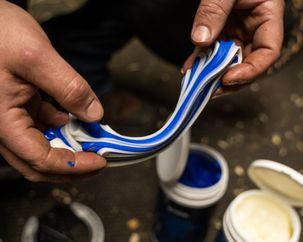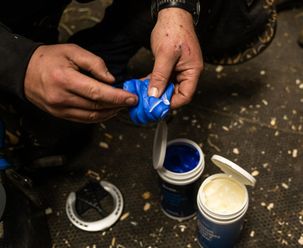Dental Impression Material and Hoof Pads for Horses
Using Dental Impression Material and Hoof Pads for Horses
The use of hoof pads for horses and other therapeutic practices in horseshoeing is nothing new, in fact it dates back to the early use of horse shoes.
In reality, it could be argued that shoeing horses was only ever a therapeutic practice aimed at either protecting the hoof or as a treatment plate?
For example, the ancient Roman Hipposandal (Ancient Horseshoe device) is commonly thought to have been used as an aid to keep hoof dressings in place temporarily. If we go back in time, and look at the history of horse shoeing, we will see that there are not many things that haven’t been tried before!
Even the introduction of rubber shoes and pads dates back to the late 1880s.
It has been said that if we don’t learn from history, we are doomed to repeat it. In this blog we will look at some of the new products available, examine their uses, as well as how they differ from those in the past.
Does the use of hoof pads for horses reduce concussion?
The horse is an amazing animal whose body is designed to reduce concussion. Without having a complete anatomy lesson, the concussion absorbing functions of a horse are its angled bones, joints, tendons, ligaments, and a correctly functioning hoof. Provided a horse’s bones are properly aligned and the foot is functioning correctly, everything should be fine!
Over the many years I have shod horses I have been asked, even told, to put pads on horses to reduce concussion!
It is my opinion that normal hoof pads for horses do not reduce concussion. The reason for this is that normal plastic or leather pads inevitably impair normal hoof function.
They do this by lengthening the hoof and covering the frog. By reducing frog function, I believe we impact normal hoof function.
Over the years, farriers have tried to counter this issue by using various forms of packing material under the pad to help the frog function. However, this too has its own problems; the packing material being either too soft, thus not enabling frog function or allowing foreign material, such as dirt, mud, or stones, to get under the pad, not to mention being dirty and unhygienic in bad conditions.
It hasn't been until recent years, with the introduction of modern polyurethanes and now Dental Impression Material that we have finally got materials that are up to the task.
So why do we need to use hoof pads for horses at all?
If a hoof is functioning normally and the angled bones are aligned there is no need to fix a problem that doesn’t exist.
On the other hand, if the horse has excessive wear to the sole or frog, or the angled bones are not aligned correctly, hoof pads help us to treat those which are not functioning normally.
For example, the horse may have abnormally thin soles due to working on an abrasive surface, like coarse sand or rocks. The farrier may apply pads to enable the horse to continue working without being uncomfortable or lame.
Equally in some cases of laminitis, pads can be employed to protect a thin sole. There are many forms of flat pads available from leather to leather & plastic combination pads as well as full 3D pads that require Dental Impression Material to be used with them.
Each case may respond differently to various combinations of pads, so attention should be paid to what combination the horse seems more comfortable with.
What are 3D pads?
If you’re a horse person that is on social media, there is a big chance you have seen 3D pads. They are all the fashion now and for a good reason!
It’s not often in horse shoeing that a product comes along and makes an impact like this one has.
The reason this product is so good is because, when combined with Dental Impression Material (DIM) it has a great ability to enhance the hoof function.
What is Dental Impression Material (DIM)?
Dental impression material is a 2-part product that is pliable prior to mixing. Once the appropriate pad has been chosen for the particular horse’s problem, the 2- parts are mixed together and applied to the solar surface of the hoof underneath the pad.
The farrier will then allow the horse to put its foot down, pressing the DIM into the foot and squeezing out any excess DIM, whilst the DIM is setting. This only takes a few minutes.


What are 3D pads used for and what do they do?
3D pads come in a variety of designs and sizes from flat full pads, Half Mesh, Wedged 2 degree & Wedged 3 degree to name a few.
You will notice with these pads, they have holes in them to allow for the excess DIM to be squeezed out during application, thus preventing excess sole pressure which can cause some horses to be uncomfortable.
3D Flat pads are usually used to help protect the solar surface in horses with thin soles. When using these pads for this purpose the sole is protected whilst the horse is working. In most cases the pads only need to be used until the sole normalises or the conditions that the horse is working on change, as soon as things are back to normal, I usually put the horse back in normal shoes. It's all about normalising the hoof from my perspective.
3D Wedge Pads come in 2 degree or 3-degree options and in a range of sizes. These pads and DIM are used in conjunction to normalise horses that may have a broken back hoof pastern angle. This results in the pedal bone being on a negative angle, thus placing more strain on the Deep Digital Flexor tendon and the Navicular area of the horses’ foot. These cases respond very well to the application of wedge pads and DIM.
Over a few shoeing cycles some horse hoofs may normalise enough to be shod again with normal shoes.
However, horses with a poor conformational fault may benefit from long term application. Remember we can influence posture, but we can’t change the conformation of an adult horse.
Dental Impression Material (DIM)
Dental impression material has been the game changer when it comes to pad application. The reason for this is the material's ability to hold its form when set.
Once it has been mixed and applied to the solar surface of the hoof under the chosen pad, it moulds into the shape of the horse’s foot as you place it on the ground. Whilst it is setting, farriers can still go about working on the horses’ other feet.
Polly-urethanes such as Comfort Mix Hoof Pad can also be used the same way; however, this requires more practice, so DIM is my preference.
The other great thing about these products is that they come in a variety of densities when set. These range from Comfort Mix Hoof Cushion Super soft (Orange), Comfort Mix Hoof Cushion Soft (Blue), Comfort Mix Hoof Cushion Medium (Purple), and Comfort Mix Hoof Cushion ZNO (Green). ZNO is designed using zinc oxide to aid in reducing thrush and infections in wet conditions.
My experience is that DIM is a very easy, user-friendly product and, when used in conjunction with pads, produces remarkable results in a relatively short period of time.
These new products have been a significant player in modern horse shoeing, as they can hold their form under the pad throughout the horse's shoeing cycle. Something that materials of the past could not do.
These products have made a huge difference to the longevity and comfort of horses with a multitude of problems.
Conclusion:
To conclude, the introduction of these new materials has changed the way farriers approach the application of hoof pads for horses. By applying these types of hoof pads with DIM, we can enhance normal foot function and normal bone alignment long term. Something we were unable to do with products of the past. Inevitably by normalising we must be helping the horse to function as its anatomy is designed to function.
Even load bearing on both the hoof and correctly angled bones, allows for even distribution of weight and normal function of ligaments, tendons, bones, and the hoof, reducing problems and enhancing the horses longevity.
Although many of these modern products were not initially designed for use on horses. Like many products of the past, they have found new roles. Modern materials are one thing that is constantly improving with science. Various glues, dental impression materials and polyurethanes have improved rapidly over the past ten years, giving farriers a greater range of options in which to treat problems. These products have positively impacted on our ability to help horses with various issues.
A little Tip for success
When I apply any Comfort Mix Hoof Cushion or Dental Impression Material, I always thoroughly clean the solar surface of the hoof with a wire brush, then apply spray glue, followed by a sprinkling of copper Sulphate, prior to the application of my chosen pad package. This will have the added advantage of reducing any infections as well as presenting you with a healthy clean hoof at your next visit.
I hope you have enjoyed this blog.
Dean Lewis AWCF


